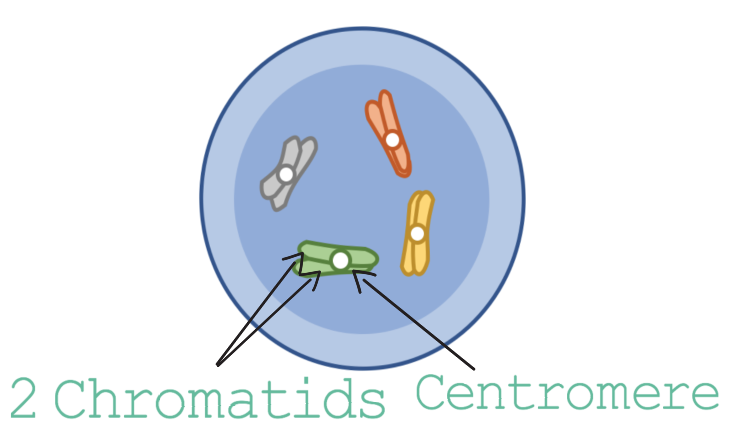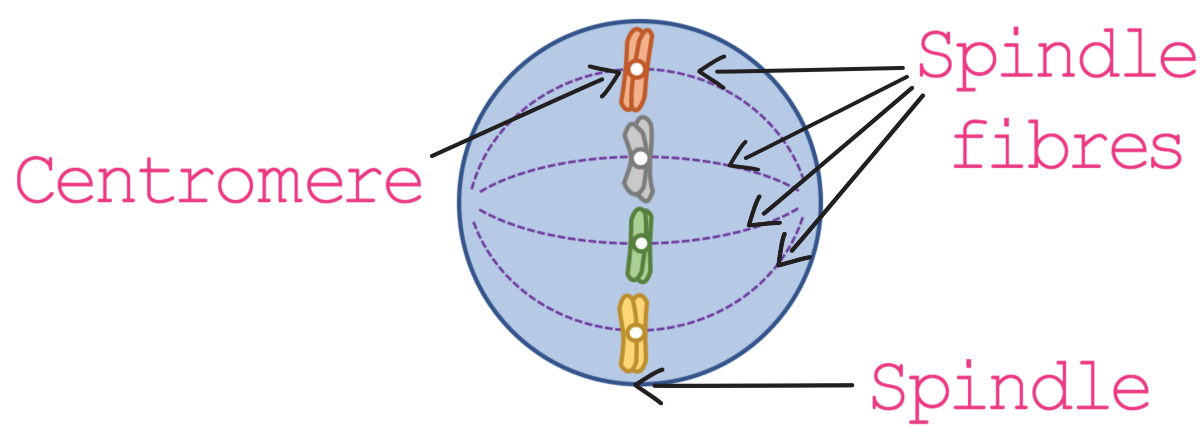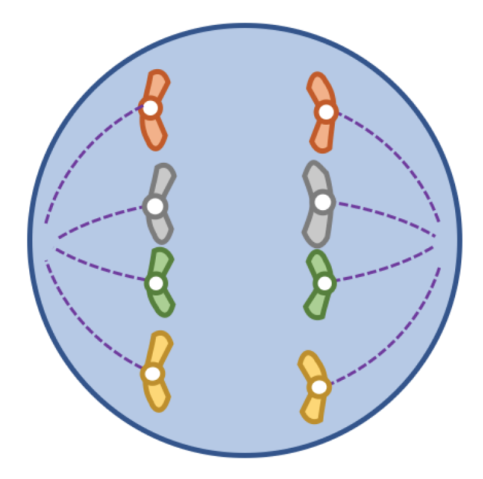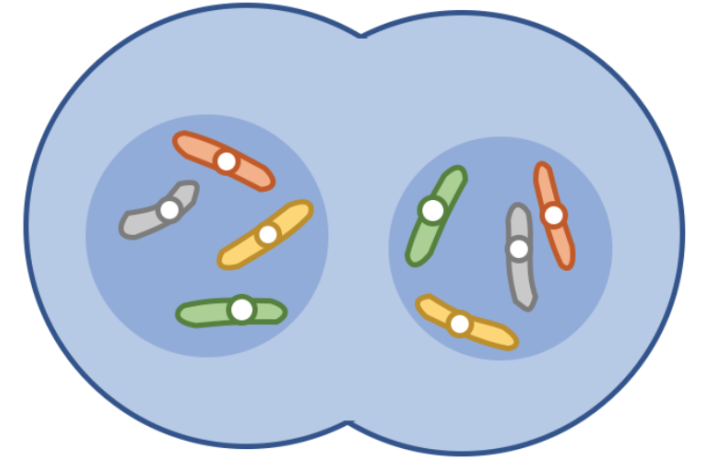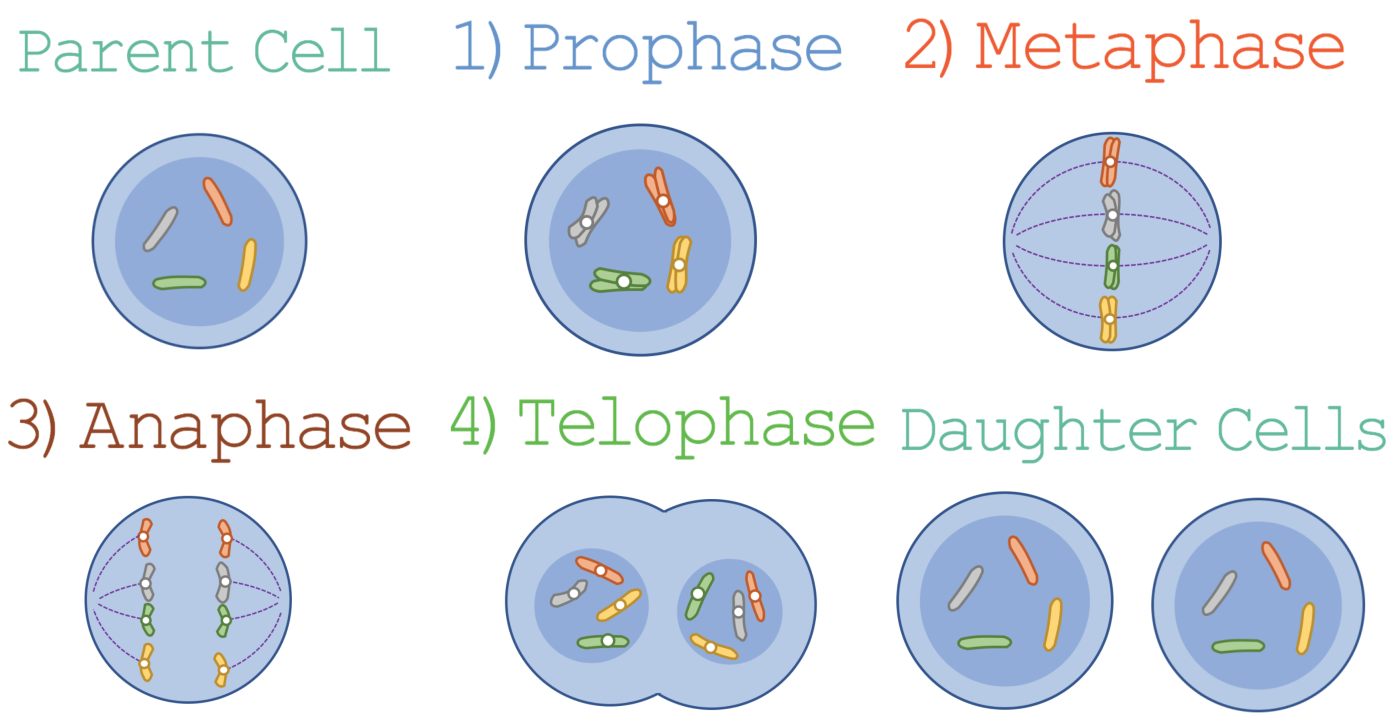1.3 Cell Multiplication – Mitosis
|
|
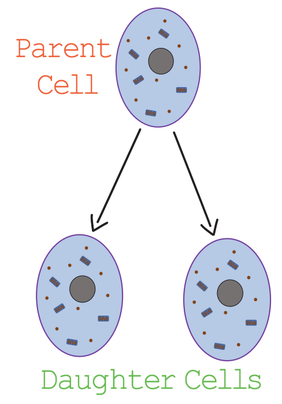 Mitosis is where a parent cell divides into two identical cells, which are known as daughter cells.
Mitosis is where a parent cell divides into two identical cells, which are known as daughter cells.
Cells multiple themselves for many reasons, such as growth, repair, cloning and asexual reproduction. There are two ways that cells can divide themselves; mitosis and meiosis. In this section, we are going to look at mitosis. A good example for mitosis is the copying of a fertilised egg. A fertilised egg is known a zygote.
Humans have 23 different chromosomes. Gametes (which are eggs and sperm) contain one of each of the 23 chromosomes. They are known as haploid cells because they have single set of unpaired chromosomes. A fertilised egg is a diploid cell because it has two sets of each chromosomes. It has one set from the sperm and another set from the egg. After an egg has been fertilised it will divide into two cells, then four, eight, sixteen etc. This dividing process will continue until the adult body contains millions of cells. The process is known as mitosis.
When a cell divides by mitosis, two cells with the same number and type of chromosomes of the original cell are formed. The mitosis process is responsible for multiplications of all cells in our body except sex cells (gametes; eggs and sperm).
The cell that is dividing (the original cell) is known as the parent cell and the two cells that are produced are known as daughter cells. Both daughter cells are genetically identical to the parent cell. To ensure that both the daughter cells are genetically identical to the parent cell, the parent cell must copy each chromosome before it divides and it must divide in such a way, so that both the daughter cells contain one copy of every chromosome. If the parent cell did not copy all the chromosomes or didn’t split correctly, it would mean that the daughter cells would not be identical to the parent cell and they won’t contain all the necessary genes.
Humans have 23 different chromosomes. Gametes (which are eggs and sperm) contain one of each of the 23 chromosomes. They are known as haploid cells because they have single set of unpaired chromosomes. A fertilised egg is a diploid cell because it has two sets of each chromosomes. It has one set from the sperm and another set from the egg. After an egg has been fertilised it will divide into two cells, then four, eight, sixteen etc. This dividing process will continue until the adult body contains millions of cells. The process is known as mitosis.
When a cell divides by mitosis, two cells with the same number and type of chromosomes of the original cell are formed. The mitosis process is responsible for multiplications of all cells in our body except sex cells (gametes; eggs and sperm).
The cell that is dividing (the original cell) is known as the parent cell and the two cells that are produced are known as daughter cells. Both daughter cells are genetically identical to the parent cell. To ensure that both the daughter cells are genetically identical to the parent cell, the parent cell must copy each chromosome before it divides and it must divide in such a way, so that both the daughter cells contain one copy of every chromosome. If the parent cell did not copy all the chromosomes or didn’t split correctly, it would mean that the daughter cells would not be identical to the parent cell and they won’t contain all the necessary genes.
The Stages of Mitosis
Pophase
The first stage of mitosis is called the prophase. During this stage, the cell copies all of it’s genetic information. This is so that the genetic information is the same in both the daughter cells and the parent cell. When a cell is not dividing, the DNA in the nucleus will be in long strands. However, when a cell is dividing the DNA will coil up forming chromosomes. The chromosomes then copy themselves. The original and copied chromosome are known as chromatids. Chromatids are one half of two identical copies of a replicated chromosome. The chromatids are joined together by a centromere. Also, during the prophase, the nuclear membrane breaks down.
Pophase
The first stage of mitosis is called the prophase. During this stage, the cell copies all of it’s genetic information. This is so that the genetic information is the same in both the daughter cells and the parent cell. When a cell is not dividing, the DNA in the nucleus will be in long strands. However, when a cell is dividing the DNA will coil up forming chromosomes. The chromosomes then copy themselves. The original and copied chromosome are known as chromatids. Chromatids are one half of two identical copies of a replicated chromosome. The chromatids are joined together by a centromere. Also, during the prophase, the nuclear membrane breaks down.
Metaphase
The next stage is the metaphase. During this stage, a structure called a spindle forms. The chromatids are attached to the spindle by the centromere (which is where the two genetically identical chromatids are joined together). The centromere release spindle fibres that go either side of the spindle (see diagram).
The next stage is the metaphase. During this stage, a structure called a spindle forms. The chromatids are attached to the spindle by the centromere (which is where the two genetically identical chromatids are joined together). The centromere release spindle fibres that go either side of the spindle (see diagram).
Anaphase
The next stage is the anaphase and this is where the spindle fibres shorten to pull the chromatids of each chromosome to opposite ends of the cell (also known as the poles of the cell).
The next stage is the anaphase and this is where the spindle fibres shorten to pull the chromatids of each chromosome to opposite ends of the cell (also known as the poles of the cell).
Telophase
The final stage is the telophase. It is where the cell membrane and cytoplasm divide to form two identical cells. The cells are identical because the spindle fibres have pulled one chromatid to opposing ends of the cell and when the cell divides through the middle, there is one copy of each chromatid in each of the daughter cells.
The final stage is the telophase. It is where the cell membrane and cytoplasm divide to form two identical cells. The cells are identical because the spindle fibres have pulled one chromatid to opposing ends of the cell and when the cell divides through the middle, there is one copy of each chromatid in each of the daughter cells.
All of the Stages of Mitosis
Frequency of Mitosis
In our bodies cells often need to be replaced and they are replaced through the process of mitosis. The frequency of mitosis depends on where the cells that we are concerned with are located. For example, when we touch something we lose thousands of cells that need to be replaced. The replacement is conducted by cells that are located underneath the surface constantly dividing. Cells in the gut and the spleen are also replaced by mitosis. This is because cells in the gut are scraped off by passing food and cells in the spleen are worn out by passing red blood cells.
In our bodies cells often need to be replaced and they are replaced through the process of mitosis. The frequency of mitosis depends on where the cells that we are concerned with are located. For example, when we touch something we lose thousands of cells that need to be replaced. The replacement is conducted by cells that are located underneath the surface constantly dividing. Cells in the gut and the spleen are also replaced by mitosis. This is because cells in the gut are scraped off by passing food and cells in the spleen are worn out by passing red blood cells.

